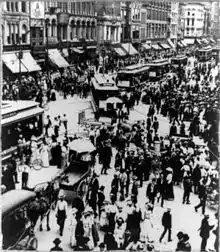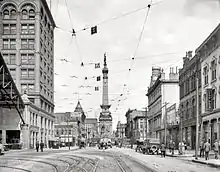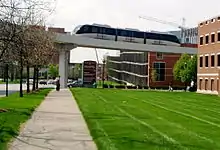Transportation in Indianapolis
Indianapolis is served by many different kinds of transportation.
History

Indianapolis was founded on the White River under an incorrect assumption that it would serve as a major transportation artery, but the river proved difficult to navigate and too shallow during much of the year.[1] After the steamboat Robert Hanna ran aground along the river in 1831, no steamboat successfully returned to Indianapolis. Flatboats continued to transport goods along a portion of the river until new dams impeded their ability to navigate its waters.[2]
The first major federally funded highway in the U.S., the National Road, reached Indianapolis in 1836,[1] followed by the railroad in 1847. By 1850, eight railroads converged in the city, ending its isolation from the rest of the country and ushering in a new era of growth.[3] Indianapolis Union Station opened in the Wholesale District on September 20, 1853 as the world's first union station.[4] Citizen's Street and Railway Company was established in 1864, operating the city's first mule-drawn streetcar line.[5][6] By 1890, electric-powered streetcars began running.[7] Opened in 1904, the Indianapolis Traction Terminal was the largest interurban station in the world, handling 500 trains daily and 7 million passengers annually.[8] Ultimately doomed by the automobile, the terminal closed in 1941, followed by the streetcar system in 1957.[9]
Indianapolis was home to the first electric carsharing service in the U.S., Bolloré Bluecar's BlueIndy. Operations launched in September 2015 and ceased in May 2020.[10][11] At the height of service, BlueIndy provided 200 electric cars and 92 charging stations throughout the city.[12]
Air transport
Indianapolis International Airport

Indianapolis International Airport, identified as IND, is the largest airport in Indiana and serves the Indianapolis Metropolitan Area. A new midfield terminal was built in 2008, with 40 gates and two concourses. There are also future plans for a third parallel runway south of I-70.
Other area air transport facilities
Cargo operations
FedEx Express, a cargo airline, operates its national hub out of IND and is its second largest hub behind only its Superhub in Memphis. FedEx has continued expanding the hub along Interstate 70, which has created additional ramp space for more wide-body aircraft and facilitated more direct flights between IND to FedEx hubs in Europe and Asia.
Cargolux, which flies to Chicago O'Hare, Los Angeles, and Luxembourg, also operates out of IND.
Highways
Interstate highways
Several interstates serve the Indianapolis area:
 Interstate 65 routes north to the Chicago area and runs south to Louisville.
Interstate 65 routes north to the Chicago area and runs south to Louisville. Interstate 69 routes north to Fort Wayne, and ends at the I-465 Beltway. Future interstate plans include extending I-69 southwest to Bloomington and Evansville, continuing through Kentucky, Tennessee, Mississippi, Arkansas, Louisiana through Texas to the Mexico border.
Interstate 69 routes north to Fort Wayne, and ends at the I-465 Beltway. Future interstate plans include extending I-69 southwest to Bloomington and Evansville, continuing through Kentucky, Tennessee, Mississippi, Arkansas, Louisiana through Texas to the Mexico border. Interstate 70 with transportation to St. Louis and Columbus.
Interstate 70 with transportation to St. Louis and Columbus. Interstate 74 to Cincinnati and Danville.
Interstate 74 to Cincinnati and Danville. Interstate 465 serves as a beltway routing around the city and connects to all of the interstate highways.
Interstate 465 serves as a beltway routing around the city and connects to all of the interstate highways. Interstate 865 serves as connector to I-65 to I-465, on the northwest side of Indianapolis.
Interstate 865 serves as connector to I-65 to I-465, on the northwest side of Indianapolis.
State roads
Among urbanized areas with 1,000,000 population or greater in the United States, Indianapolis ranked tenth in freeway lane miles per 1,000 population and eighth in freeway-equivalent miles per 1,000 population, according to 1999 data.[13]
Mass transit

The Indianapolis Public Transportation Corporation, known locally as IndyGo, provides public transportation for the city. IndyGo was established in 1975 after the city of Indianapolis took over privately owned Indianapolis Transit Systems, Inc. Prior to 1997, IndyGo was called Metro. Central Indiana Commuter Services (CICS), funded by IndyGo to reduce pollution, serves Indianapolis and surrounding counties.
Historically, Indianapolis had an extensive network of streetcar routes. In 1953, the last streetcars ran in the city. Trolleybuses made their last run in the city four years later in 1957, leaving the city with an all-bus transit system. The Downtown Indianapolis Streetcar Corp., a not-for-profit organization, is investigating the feasibility of a streetcar line to serve various downtown destinations.[14]
A report prepared by Purdue University indicated that buses running on a fuel containing 10 percent biodiesel are likely to help Indianapolis mass transit reduce pollution without compromising fuel economy. The report also suggests introducing more hybrid diesel-electric buses and a fuel containing 20 percent biodiesel (BD20) would further reduce emissions and petroleum consumption.[15]
IndyGo's Red Line is a bus rapid transit line running from Broad Ripple Village on the north side to the University of Indianapolis on the south side. Construction started in May 2018 and the line opened for service on September 1, 2019, using all electric buses.[16] It is part of a larger plan known as the Marion County Transit plan.[17]
People mover

The Indiana University Health People Mover formerly linked the Indiana University School of Medicine with the medical centers of University Hospital, Riley Hospital for Children, Methodist Hospital, and related facilities on the campus of Indiana University – Purdue University Indianapolis (IUPUI). It was shut down in February 2019. The people mover was sometimes inaccurately described as a monorail, but in fact rode on dual concrete beams with the guideway as wide as the vehicle.
Intercity transportation
Amtrak, the national passenger rail system, provides service to Indianapolis at the Indianapolis Union Station. Amtrak provides the tri-weekly service of the Cardinal to Chicago, New York City, and Washington, D.C. The Hoosier State provided service to Chicago on days the Cardinal does not operate. That service stopped on June 30, 2019, because funding for the service was not included in the state’s 2019–2020 budget.
Greyhound Lines operates a bus terminal at Union Station downtown and at Indianapolis International Airport's Ground Transportation Center.[18] Megabus also runs from downtown Indianapolis, stopping on North Alabama Street adjacent to the Indianapolis City Market.[19]
References
- Baer, p. 11, and Hyman, p. 34.
- Brown, p. 20, and Edward A. Leary (1971). Indianapolis: The Story of a City. Indianapolis: Bobbs-Merrill. p. 35.
- Bodenhamer and Barrows, p. 1480; Brown, pp. 34 and 52–53; Hale, p. 21; and Indianapolis, A Walk Through Time, p. 13.
- "Indianapolis Union Railroad Station". Discover Our Shared Heritage Travel Itinerary. Washington, D.C.: National Park Service. Retrieved August 11, 2015.
- Brown, p. 50.
- Sulgrove, pp. 134, 424–26.
- Hale, p. 54.
- "Transportation in Indianapolis: then and now". Indianapolis Public Transportation Corporation. Archived from the original on August 26, 2014. Retrieved August 28, 2014.
- O'Malley, Chris (August 27, 2011). "Backer seek support for 2-mile streetcar line downtown". Indianapolis Business Journal. Retrieved February 7, 2016.
- Hwang, Kellie (February 12, 2020). "BlueIndy: Experts weigh in on why the car-sharing service didn't work". The Indianapolis Star. Retrieved May 23, 2020.
- Briggs, James (August 8, 2017). "After a rocky start, BlueIndy is making peace and winning over customers". The Indianapolis Star. Retrieved August 21, 2019.
- Colombo, Hayleigh (August 2, 2019). "Four years in, Blue Indy car-sharing service still stuck in red". Indianapolis Business Journal. Retrieved August 3, 2019.
- "Highway & Motorway Fact Book: Index". www.publicpurpose.com. Retrieved June 8, 2019.
- "IBJ.com Story Detail". Ibj.com. Retrieved November 6, 2008.
- "Emerging Energy News: Purdue: Biodiesel cuts carbon emission from buses". Energycurrent.com. Archived from the original on September 22, 2008. Retrieved November 6, 2008.
- "Project Overview". IndyGo Red Line. Retrieved June 8, 2019.
- "Transit Plan | Better Bus Service Keeps Coming". IndyGo. Retrieved June 8, 2019.
- "Bus stations in Indianapolis, IN | Greyhound". Greyhound. Retrieved June 8, 2019.
- "Bus Stops | megabus". us.megabus.com. Retrieved June 8, 2019.